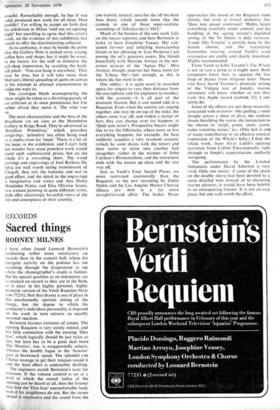ART
Rio revue
EVAN ANTHONY
The Brazilians have invaded the London art scene: three shows currently on view. It would seem that in addition to the coffee and nut yield, some feel there is another national product ripe for exploitation. With apologies to Marshall McLuhan I suggest that, where galleries are concerned, (-the aria biance is the massage' .and the Brazilian exhibitors might profitably consider the influence of gallery ambiance when evaluating the. success of their present shows, and in preparing for their next.
Sergio De Camargo is doing reasonably well. He's at Gimpel Fils in South Molton Street. He last exhibited there in 1968. and will surely want to again, noting: good location in the gallery greenbelt; reputation for showing smart, avant-garde work professional staff capable- of quoting four- figure prices without batting an eyelash: impressively printed. catalogue, carelly minus a propaganda piece (just the facts, ma'am).
Camargo's work shouldn't prompt anyone to say, `Ah, Brazilian, of course,' unless it is felt that the colour of his white spray-painted `Reliefs' was influenced by the bright sun of the artist's native land. These 'reliefs'• are composed of slices of wooda cylinder, mounted on wooden panels.- The variety of the 'sizes and angles of his wooden bits "enables Camargo .to create either a richly textured or stark effect. The panels are interestingly decorative, tastefully presented. but I lack the language to make a meal of discussing them in deeper terms: It's the kind of work that-will prompt your friends to say emphatically, 'I like that' (epd of comment'. or cautiously,- 'Interesting:- After a fon' weeks of. seeing it hanging on the wall. it May move your wife or housemaid to observe, 'It's hell to dust.' • Roberto - Morvan, at the Gallery Petit• Marble Arch, 'is having his third show this year—one at the Brazilian Embassy Showroom in London, another in Milan. and the third at this gallery, opened last week in the presence of the Brazilian cultural attaché. Remarkably enough, he has (I was told) produced new work for all three. How prolific! I'm willing to accept on faith that his exhibition in Milan 'sold out on opening night' but unwilling to agree that this artist's work, on the evidence of this exhibition, has much to offer the discriminating collector.
As to ambiance, it may be beside the point that the Gallery Petit is tucked away among coffee bars and shops, but it might be wiser, in the future, for the staff to minimise the gift-shop impression, by avoiding the hard- sell pitch: `You can hang it anywhere.' That may be true, but it will lake more than Morvan's liberal spreading of paint on canvas in his attempt at abstract expressionism to make me want to.
The catalogue blurb accompanying the show might be taken as a diverting parody of art criticism at its most pretentious, but I'm rather afraid they mean it. The wine was
OK.
The most characteristic and the best of the Brazilians are on view at the Mannheim Gallery in Kings Road. They're advertised as 'Brazilian Primitives,' which provokes misgivings, 'primitive' too often being used as a euphemism for 'inept.' There is a bit of the inept in the exhibition, and I can't help but wonder how some primitive work would merit such sophisticated prices, but on the whole it's a rewarding show. The wood carvings and engravings of Josi Barbosa Da Silva are well worth seeing (reminiscent of Chagall, they mix the fantastic and real to good effect, and the detail in the engravings is imaginative and witty) and Ana Dulca Moutinho Ninita and Elza Oliveira Souza, two women painting in quite different styles, both offer charmingly beautiful views of the life and atmosphere of their country.















































 Previous page
Previous page